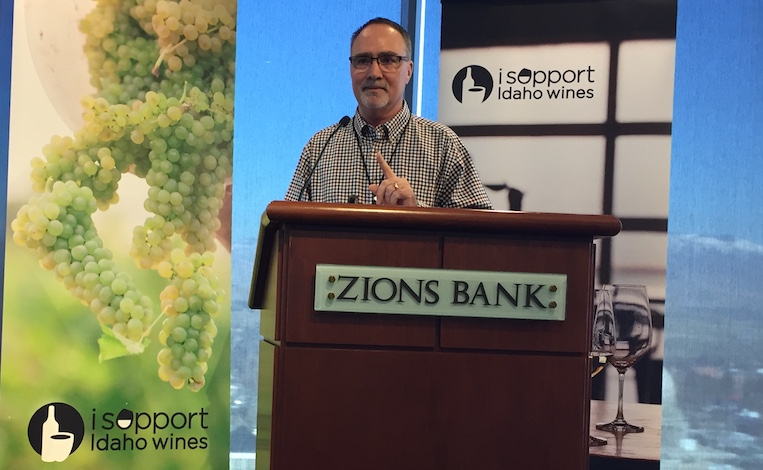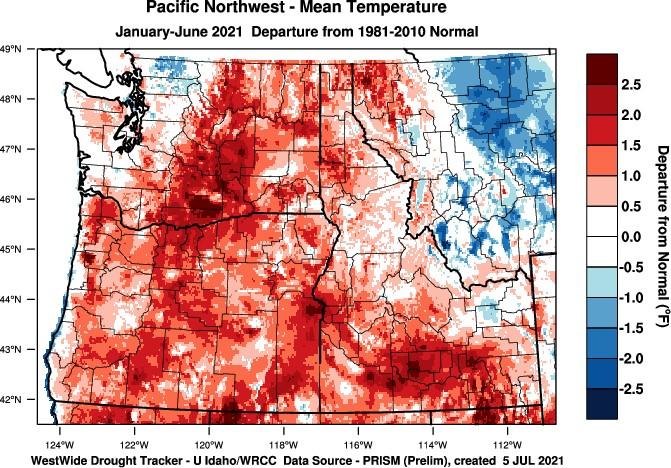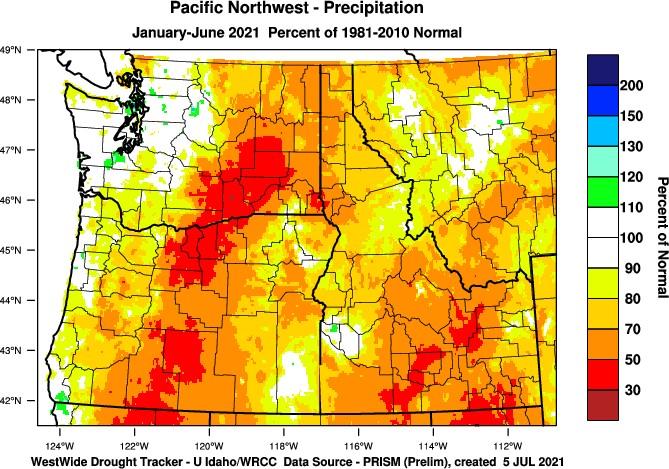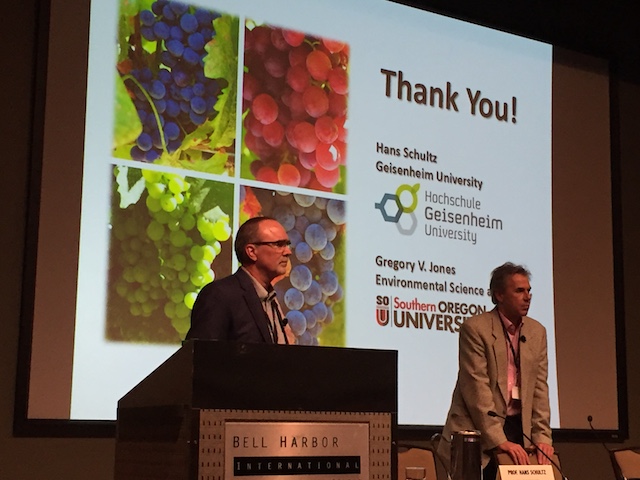
The July 2021 Weather and Climate Summary and Forecast by renowned environmental scientist Greg Jones brought a sobering outlook for the Northwest wine industry in terms of conditions similar to the historically hot 2015 vintage, and the monthly report included news that Jones has resigned from Linfield University in McMinnville, Ore.
“With this month’s Weather-Climate Summary and Forecast, I am transitioning to posting the report on my personal website as I am leaving Linfield University in a few days,” wrote Jones, the director of the school’s wine studies program.
Several scandals involving Linfield administration and trustees have generated headlines at the private university with Baptist roots and led to frustration among faculty. Michael Alberty of The Oregonian reported that two other Linfield employees with ties to the wine studies program also have resigned or announced their decision to leave the school within the next 12 months.
“I built something very rewarding in four years, but it’s time to move on,” Jones wrote in an email to Great Northwest Wine. “I have a couple of options both internationally and nationally and am working on a plan, but I’m not in any rush.”
In the meantime, Jones has launched ClimateOfWine.com, which seems appropriate for a contributing author to an international climate report that merited a Nobel Prize in 2008. Jones is listed almost annually among Wine Business Monthly magazine’s Top 50 Wine Industry Leaders, and he has provided critical climate input to petitions that have led to the establishment of several American Viticultural Areas in the Pacific Northwest.
Seattle symbolizes heat, drought conditions

Records fell throughout the Northwest during the heatwave in the second half of June, including the all-time mark of 104 at Seattle-Tacoma International Airport on June 27. Time will tell if the Emerald City will erase the 2017 record of 55 rainless days, but the current string began on June 14 and there’s no end in sight.
Idaho’s Snake River Valley came within one degree on Wednesday of what would have been a record 10th consecutive day of temperatures reaching 100 degrees.
And now the entire Pacific Northwest is bracing itself for a second “heat dome” next week.
“Last month’s forecast called for extreme heat later in the month, but I do not think anyone thought that it would be as extreme as it was,” Jones wrote. “Daily and all-time records were broken for maximum and high minimums across hundreds of locations across the west. As a result, the month ended up substantially warmer than average over the west with some areas seeing temperatures 6-8°F above average for the month.”
In terms of growing degree days, the second half of June of 2021 prompts winemakers and growers to look back at historically hot 2015.
“Compared to the 2015 vintage, one of the warmest years on record, Medford, Roseburg, and McMinnville are now within a percent or two, while Milton-Freewater is roughly 12% below the GDD accumulated during the 2015 vintage,” Jones wrote. “Compared to the 2020 vintage, the four locations are currently 8 to 34% above.”
By the end of June, the McMinnville recording station Jones monitors accrued 859 GDD. In 2015, it stood at 898. In Roseburg, at the Jones family’s Fault Line Vineyards planting for Abacela, there were 1,119 GDD to start July. Six years ago, it read 1,176.
In the Rogue Valley city of Medford, it is 2021 that’s ahead of 2015 with 1,321 GDD vs. 1,300. And in the Walla Walla Valley town of Milton-Freewater, Ore., the current vintage stood more moderate at 1,197 GDD. In 2015, there were nearly 200 more GDD (1,384).
Washington State University’s AgWeatherNet logs growing degree days via its 177 stations across the state as well as parts of Oregon and Idaho.
Through June 30, there were 1,294 growing degree days recorded at the East Mattawa Station on the Wahluke Slope. A year ago, it charted 1,047 GDD. During the 2015 vintage, it stood at 1,349 when July began.
At the Benton City station near Red Mountain, there were 1,406 GDD recorded. A year ago, it read 1,152 GDD. In 2015, there were 1,445 GDD.
The North Sunnyside station in the Yakima Valley collected 1,165 GDD. A year ago, the accumulation stood at 980 GDD. During the blistering 2015 season, it was 1,235.
At Phinny Hill Vineyard in Klickitat County’s Horse Heaven Hills, that station measured 1,195 GDD. In 2020, it read 1,002. Back in 2015, before the temperatures really began to race in the Columbia Valley, there were 1,255 heat units.
Along the Columbia Gorge, Husum notched 824 GDD. A year ago, it stood at 617. The Pullman school’s station in Woodinville collected 677 GDD, compared with 569 GDD last year. Back in 2015, it received 759.
This year, a number of vineyards in Idaho’s Snake River Valley became integrated into AgWeatherNet. Canyon County northwest of Boise includes historic Sawtooth Vineyard, which had achieved 1,225 GDD, with young Scoria Vineyard on the Sunnyslope at 1,238 and Rose Cottage near vaunted Fraser Vineyard at 1,273. Representing Ada County there is young Dude DeWald at 1,195 and 3 Horse Ranch in the Eagle Foothills AVA with 1,116.
In the bi-state Lewis-Clark Valley AVA, Umiker Estate Vineyard at Clearwater Canyon Cellars in Lewiston, Idaho, reported 1,272 growing degree days.
Early runoff compounds drought concerns

In Washington wine country, while spring temperatures were near normal, rainfall was about 25% of normal. According to the Washington State Department of Ecology, the statewide average ranked the period of March through May as the second-driest spring since 1895. Only the spring of 1924 was drier.
And then came the rapid mountain runoff as a result of the heat dome.
“Over 98% of the West is in some level of drought, with only a small area of the northern Cascades and northern Rockies not in drought at this time,” Jones wrote, adding, “Both the monthly outlook (July) and long-term outlook for the US through September continue the forecasted dry conditions for much of the west with further development expected in the Rockies, Montana, Idaho and the PNW.”
Ironically, while the Pacific Northwest has been withering in historic heat during its 2021 growing season, conditions for the 2021 vintage were idyllic Down Under.
This week, Wine Australia reported a record crop as part of a “unicorn” 2021 vintage, which officials described as “a season characterised by near-perfect growing and ripening conditions across most states and regions.”
Jones leaves Linfield after 4 years

Jones earned his Ph.D in environmental sciences at the University of Virginia then spent 20 years as a professor at Southern Oregon University until he resigned in 2017 to succeed Ellen Brittan as director of Linfield’s Center for Wine Education. The following year, the owners of Oregon’s famed Domaine Serene donated $6 million to establish the Grace and Ken Evenstad Center of Wine Education, which created an endowed faculty position and the Evenstad Wine Laboratory.
Ken Evenstad died Oct. 21, 2020 at the age of 77, two years after he and Grace received Wine Spectator magazine’s Distinguished Service Award.
Jones plans to spend at least a portion of the summer seeking relief from the next heat dome while at the recreational property along the Oregon Coast that he and his wife, Liz, have.
“I will take the time to refresh and do some writing,” Jones wrote.

Leave a Reply